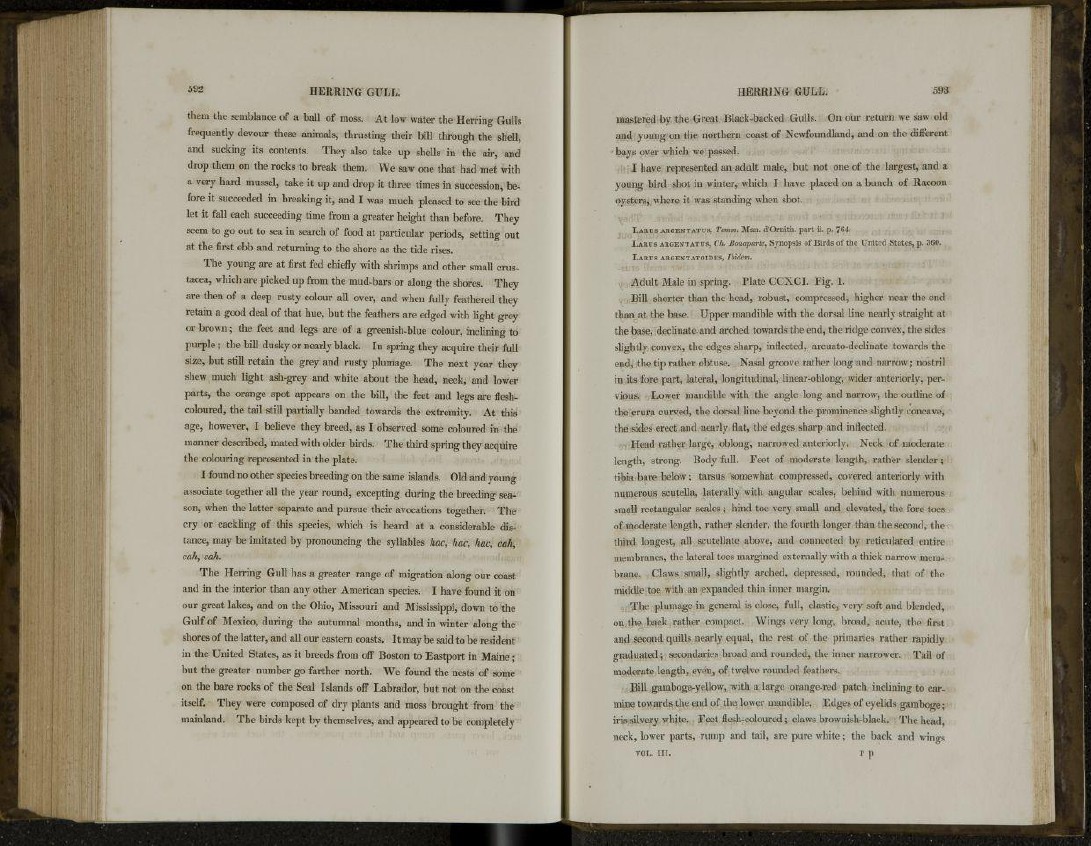
592 HERRING GULL,
them the semblance of a ball of moss. At low water the Herring Gulls
frequently devour these animals, thrusting their bill through the shell,
and sucking its contents. They also take up shells in the air, and
drop them on the rocks to break them. We saw one that had met with
a very hard mussel, take it up and drop it three times in succession, before
it succeeded in breaking it, and I was much pleased to see the bird
let it fall each succeeding time from a greater height than before. They
seem to go out to sea in search of food at particular periods, setting out
at the first ebb and returning to the shore as the tide rises.
The young are at first fed chiefly with shrimps and other small Crustacea,
which are picked up from the mud-bars or along the shores. They
are then of a deep rusty colour all over, and when fully feathered they
retain a good deal of that hue, but the feathers are edged with light grey
or brown; the feet and legs are of a greenish-blue colour, inclining to
purple; the bill dusky or nearly black. In spring they acquire their full
size, but still retain the grey and rusty plumage. The next year they
shew much light ash-grey and white about the head, neck, and lower
parts, the orange spot appears on the bill, the feet and legs are fleshcoloured,
the tail still partially banded towards the extremity. At this
age, however, I believe they breed, as I observed some coloured in the
manner described, mated with older birds. The third spring they acquire
the colouring represented in the plate.
I found no other species breeding on the same islands. Old and young
associate together all the year round, excepting during the breeding season,
when the latter separate and pursue their avocations together. The
cry or cackling of this species, which is heard at a considerable distance,
may be imitated by pronouncing the syllables hac, hac, hac, cah,
cah, cah.
The Herring Gull has a greater range of migration along our coast
and in the interior than any other American species. I have found it on
our great lakes, and on the Ohio, Missouri and Mississippi, down to the
Gulf of Mexico, during the autumnal months, and in winter along the
shores of the latter, and all our eastern coasts. It may be said to be resident
in the United States, as it breeds from off Boston to Eastport in Maine;
but the greater number go farther north. We found the nests of some
on the bare rocks of the Seal Islands off Labrador, but not on the coast
itself. They were composed of dry plants and moss brought from the
mainland. The birds kept by themselves, and appeared to be completely
HERRING GULL. 593
mastered by the Great Black-backed Gulls. On our return we saw old
and young on the northern coast of Newfoundland, and on the different
bays over which we passed.
I have represented an adult male, but not one of the largest, and a
young bird shot in winter, which I have placed on a bunch of Racoon
oysters, where it was standing when shot.
LARUS ARGENTATUS, Temm. Man. d'Ornith. part ii. p. 764.
\
LARUS ARGENTATUS, Ch. Bonaparte, Synopsis of Birds of the United States, p. 360.
LARUS ARGENTATOIDES, Ibidem.
Adult Male in spring. Plate CCXCI. Fig. 1.
Bill shorter than the head, robust, compressed, higher near the end
than at the base. Upper mandible with the dorsal line nearly straight at
the base, declinateand arched towards the end, the ridge convex, the sides
slightly convex, the edges sharp, inflected, arcuato-decliriate towards the
end, the tip rather obtuse. Nasal groove rather long and narrow; nostril
in its fore part, lateral, longitudinal, linear-oblong, wider anteriorly, pervious.
Lower mandible with the angle long and narrow, the outline of
the crura curved, the dorsal line beyond the prominence slightly concave,
the sides erect and nearly flat, the edges sharp and inflected.
Head rather large, oblong, narrowed anteriorly. Neck of moderate
length, strong. Body full. Feet of moderate length, rather slender;
tibia bare below; tarsus somewhat compressed, covered anteriorly with
numerous scutella, laterally with angular scales, behind with numerous
small rectangular scales; hind toe very small and elevated, the fore toes
of moderate length, rather slender, the fourth longer than the second, the
third longest, all scutellate above, and connected by reticulated entire
membranes, the lateral toes margined externally with a thick narrow membrane.
Claws small, slightly arched, depressed, rounded, that of the
middle toe with an expanded thin inner margin.
The plumage in general is close, full, elastic, very soft and blended,
on the back rather compact. Wings very long, broad, acute, the first
and second quills nearly equal, the rest of the primaries rather rapidly
graduated; secondaries broad and rounded, the inner narrower. Tail of
moderate length, even, of twelve rounded feathers.
Bill gamboge-yellow, with a large orange-red patch inclining to carmine
towards the end of the lower mandible. Edges of eyelids gamboge;
iris silvery white. Feet flesh-coloured; claws brownish-black. The head,
neck, lower parts, rump and tail, are pure white; the back and wings
VOL. in. r p